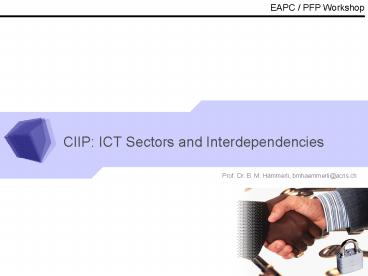CIIP: ICT Sectors and Interdependencies - PowerPoint PPT Presentation
1 / 21
Title:
CIIP: ICT Sectors and Interdependencies
Description:
Economy of Scale and Decentralization / Centralization ... Laptop until end of battery. Desk Top. EAPC / PFP Workshop. Zurich, September 23, 2005 ... – PowerPoint PPT presentation
Number of Views:86
Avg rating:3.0/5.0
Title: CIIP: ICT Sectors and Interdependencies
1
CIIP ICT Sectors and Interdependencies
2
Some Inputs to stimulate the ICT GroupSector and
Interdependency Discussion
- Content
- From Monopoly to Free Market
- Economy of Scale and Decentralization /
Centralization - Interconnection of Services and Interdependencies
- Domino effect
- Example Family Home
- Our Task today
- Conclusion
3
Introduction
- Definition Criticality of Services
- Services, organizations and institutions,
- which are
- (absolutely) essential to the public community
- such that
- failure or disruption of which
- will result in
- long-lasting supply bottlenecks and/or other
dramatic consequences - for substantial elements of the community are
considered as critical - A Sector consists of one or Multiple Services
- Later Definition Vulnerability of Systems /
Threat / Asymmetric Threat /Domino or Cascading
Effects / Interdependencies
4
Situation Analysis and Needs Service Supply of
Nations From Monopoly to Free Market
- From Monopoly to Free Market
- Free Market introduced
- Competition (lowest rate possible)
- Many service provider with corporate security
- Delegation of the supply task
- Overall guarantee of supply and its securing
measures skipped - Structure is still centralized,
- (partly with common nodes and/or
Infrastructure (Telco) - CIP is the answer to secure the old fashioned
public service for (inter) national purpose
Security
Task
For each Nation
Security ?
Task
Task
Task
Task
Task
Task
Task
Task
Task
5
Situation Analysis and Needs I Why we have this
challenge by now?Efficiency vs. Robustness
Processes, Infrastructure Services
6
Situation Analysis and Needs Economy of Scale /
Decentralization 1
- Economy of Scale
Production cost in regular situations are often
lower with a centralized approach Security
measures are applied, but central vulnerabilities
remain Decentralization as a mean to make
infrastructure robust
Management Center
Logical channel for management information
7
Conventional Central Station Based Power
Systempartly with Decentralized Generation
Coal ?
Overloaded/Congested Transmission Lines
Industrial
Nuclear ?
Nat. Gas ?
Commercial
GeneratorSubstation
DistributionSubstation
Petroleum ?
Residential
This and the next slides are from Prof. Dr.
Saifur Rahman, Director Alexandria Research
Institute, VA-Tech USA
Hydro ?
8
Situation Analysis and Needs Economy of Scale /
Decentralization 3 Distributed Generation
Technologies
Solar Cells
Wind Turbines
9
Dependency and Interdependency
A depends on B
Interdependent or mutual dependent
By Suanne Jantsch
10
Infrastructure Sectors and its Interconnection
11
Situation Analysis and Needs Interconnected CIP
View from EU Project ACIP
Socio-economic Models Gaming Scenario Techniques
System Dynamics Empirical Modeling etc.
System Simulation Optim. Algorithms Human
Behavior Mod.
Technical Simulation Technical
Experimentation etc.
Green Basic and Essential Services
IABG Schmitz (2002)
12
31 Interconnected Critical Services in the
Netherlands
13
Sectors according NISCC UK
14
Situation Analysis and Needs New Threats
Interdependencies are structured!
The nature of systems implies, that not all
dependencies are as important. Basically has
energy first priority, followed by
telecommunication.
Transport / Traffic / Postal ServicesRescue /
Health Care DisposalGovernment and
AdministrationGas / Oil supplyWatera. s. o.
Applications
View of InfoSurance Switzerland
Finance Applications
Operating System / Middleware
Communication
Electricity
Physical Thread
15
Trends and Good Practice in Getting Started
(Example CH) IVInfoSurance Example Common
Generic Risks in CI(I)P
- Round Tabel Generic Risks, InfoSurance Spring
2003 - 2 Types of Risks
- Core Risks
- Application Risks
- Idea Share Risks identified in other sectors to
speed up the risk analysis process - Common Risk or dependability? !
16
Domino Effects
17
Dependencies from Energy SectorExample Family
Home
- No Electrical Energy
- Food
- Cooking Gas or Electricity
- Deep Freezer 10 Hour to warm up!
- Light Candles, Camp Ground Solutions
- Telephone
- Mobile
- Wired Cordless, Simple Phones
- Heating
- Oil (not working because of electrical burning
system) - Open Fire
- Computing / Internet
- Laptop until end of battery
- Desk Top
18
Emergency Communication
19
Our Task
- Task I
- Your and your Country's understanding of a
sector - interdependencies, generally and specifically in
your country - Task II ICT / Communication
- What does fail, when ICT does not work?
- Generally in all country
- Country specific
20
Situation Analysis and NeedsConclusions and
Strategies
- Architecture Future Infrastructure Design (New
Threats, Free Market) - Migration towards future Architecture
(decentralization, redundancy and separation of
information and steering- control layer) - Making existing infrastructure resilient
(multiple simultaneous attacks) e.g. through
decentralization and segregation (Information
and Control Level) - Granularity of CIP models (long discussion
process of experts needed) - Decentralize infrastructure and make critical
infrastructure (the sectors and the suppliers
within the sectors) as much as possible
independent from each other - Avoid centralized and common single point of
failure (requires extensive analysis (e.g. telco
common lines)) - Centralize the management platform of
decentralized systems to gain as much status
knowledge as possible for taking the best
decisions in case of failure. Have several back
up of the management centers. - Lack of models / contracts with international
corporation (are benefit-oriented, no special
loyalty to nations, security is a limited
issue)? Nations should negotiate and clarify
these situations (risk assessment) - CIP Middleware is missing (From Monopoly -gt
Free Market) - Top down Policy approach is brought in to
nations thinking - Bottom up Corporation do an enormous effort in
BCP, DRP and IT Security - In between is the CIP Middleware, Information
Sharing Centers (ISAC), topic to be defined
(Automatic mutual support, building CI(I)P
Communities)There is a enormous effort in
corporate and sectors CI(I)P today.To integrate
this complex infrastructure and its interfaces in
a national or transnational CI(I)P plan is one of
the most challenging CIP Task
21
Questions

